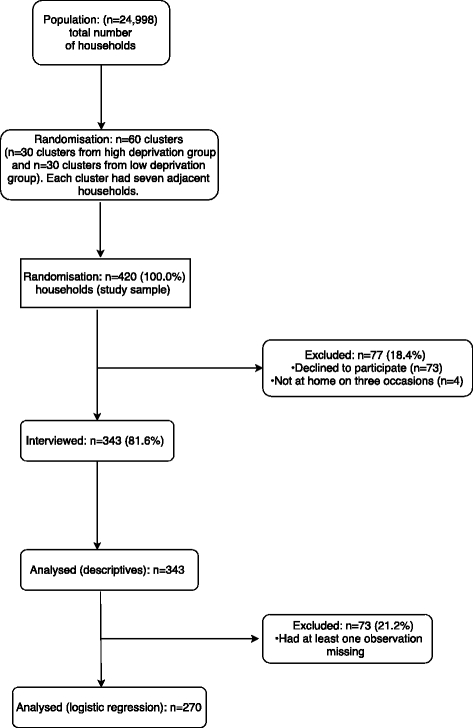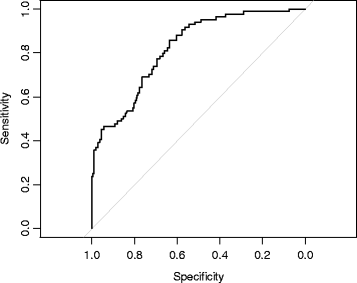Determinants of self-rated health in an Irish deprived suburban population - a cross sectional face-to-face household survey
- PMID: 27515433
- PMCID: PMC4982417
- DOI: 10.1186/s12889-016-3442-x
Determinants of self-rated health in an Irish deprived suburban population - a cross sectional face-to-face household survey
Abstract
Background: Self-rated health (SRH) is amongst the most frequently assessed health perceptions in epidemiological research. While there is a growing understanding of the role of SRH, a paradigm model has yet to be widely accepted with recent studies concluding that further work is required in determining whether there are important predictors of SRH yet to be highlighted. The aim of this paper is to determine what health and non-health related factors were associated with SRH in a suburban deprived population in Dublin, Ireland.
Methods: A cross sectional face-to-face household survey was conducted. Sampling consisted of random cluster sampling in 13 electoral divisions, with a sampling frame of 420 houses. Demographic information relating to the primary carer was collected. Health status of the primary carer was measured through SRH. Household level data included the presence or absence of persons with a chronic disease, persons who smoked, persons with a disability and healthcare utilisation of general practitioner and hospital level services. A logistic regression model was utilised in the analysis whereby the odds of primary carers with poor SRH were compared to the odds of carers with good SRH taking health and non-health related factors into account.
Results: Of the 420 households invited to participate a total of 343 were interviewed (81.6 % response rate). Nearly half of the primary carers indicated their health as being 'good' (n = 158/342; 46.2 %). Adjusting for the effects of other factors, the odds of primary carers with second level education were increased for having poor SRH in comparison to the odds of those with third level education (OR 3.96, 95 % CI (1.44, 11.63)). The odds of primary carers who were renting from the Council were increased for having poor SRH compared to the odds for those who owned their own property (OR 3.09, 95 % CI (1.31, 7.62)). The odds of primary carers that were unemployed (OR 3.91, 95 % CI 1.56, 10.25)) or retired, ill or unable to work (OR 4.06, 95 % CI (1.49, 11.61)) were higher for having poor SRH than the odds of those in employment. If any resident of the household had a chronic illness then the odds of the primary carer were increased for having poor SRH compared to the odds for a primary carer in a household where no resident had a chronic illness (OR 4.78, 95 % CI (2.09, 11.64)). If any resident of the household used the local hospital, the odds of the primary carer were increased for having poor SRH compared to the odds for the primary carer in a household where no resident used the local hospital (OR 2.01, 95 % CI (1.00, 4.14)).
Conclusions: SRH is affected by both health and non-health related factors. SRH is an easy to administer question that can identify vulnerable people who are at risk of poor health.
Keywords: Chronic illness; Community; Deprivation; Education; Employment; Hospital use; Predictor; Self-rated health.
Figures
Similar articles
-
Factors associated with self-rated health status in Southwestern Iran: a population-based study.Public Health. 2016 Nov;140:179-185. doi: 10.1016/j.puhe.2016.06.027. Epub 2016 Aug 3. Public Health. 2016. PMID: 27498159
-
Increasing educational inequalities in self-rated health in Brazil, 1998-2013.PLoS One. 2018 Apr 30;13(4):e0196494. doi: 10.1371/journal.pone.0196494. eCollection 2018. PLoS One. 2018. PMID: 29708990 Free PMC article.
-
Trends in self-rated health and association with socioeconomic position in Estonia: data from cross-sectional studies in 1996-2014.Int J Equity Health. 2016 Dec 8;15(1):200. doi: 10.1186/s12939-016-0491-9. Int J Equity Health. 2016. PMID: 27931236 Free PMC article.
-
Systematic review: Self-rated health of Arab immigrants in the United States.Public Health Nurs. 2019 Sep;36(5):623-630. doi: 10.1111/phn.12640. Epub 2019 Jul 15. Public Health Nurs. 2019. PMID: 31304997
-
Determinants of self rated health for Canadians with chronic disease and disability.J Epidemiol Community Health. 1999 Nov;53(11):731-6. doi: 10.1136/jech.53.11.731. J Epidemiol Community Health. 1999. PMID: 10656104 Free PMC article. Review.
Cited by
-
Link between perceived oral and general health status among Yemeni adult dental patients.BMC Oral Health. 2019 May 28;19(1):93. doi: 10.1186/s12903-019-0793-6. BMC Oral Health. 2019. PMID: 31138198 Free PMC article.
-
One Month into the Reinforcement of Social Distancing due to the COVID-19 Outbreak: Subjective Health, Health Behaviors, and Loneliness among People with Chronic Medical Conditions.Int J Environ Res Public Health. 2020 Jul 27;17(15):5403. doi: 10.3390/ijerph17155403. Int J Environ Res Public Health. 2020. PMID: 32727103 Free PMC article.
-
Late-life depression in sub-Saharan Africa: lessons from the Ibadan Study of Ageing.Epidemiol Psychiatr Sci. 2020 Jul 20;29:e145. doi: 10.1017/S2045796020000578. Epidemiol Psychiatr Sci. 2020. PMID: 32684193 Free PMC article.
-
Self-rated health as a valid indicator for health-equity analyses: evidence from the Italian health interview survey.BMC Public Health. 2019 May 9;19(1):533. doi: 10.1186/s12889-019-6839-5. BMC Public Health. 2019. PMID: 31072306 Free PMC article.
-
Perceptions of Oral Health and Quality of Life among Parents in Kuwait.Oral Health Prev Dent. 2023 Apr 24;21:121-130. doi: 10.3290/j.ohpd.b4043017. Oral Health Prev Dent. 2023. PMID: 37093178 Free PMC article.
References
-
- Hu A, Hibel J. Educational attainment and self-rated health in contemporary China: A survey-based study in 2010. Soc Sci J. 2013;50:674–80. doi: 10.1016/j.soscij.2013.04.013. - DOI
-
- Hämmig O, Gutzwiller F, Kawachi I. The contribution of lifestyle and work factors to social inequalities in self-rated health among the employed population in Switzerland. Soc Sci Med 1982. 2014;121:74–84. - PubMed
-
- Drydakis N. The effect of unemployment on self-reported health and mental health in Greece from 2008 to 2013: a longitudinal study before and during the financial crisis. Soc Sci Med 1982. 2015;128:43–51. - PubMed
MeSH terms
LinkOut - more resources
Full Text Sources
Other Literature Sources
Medical



